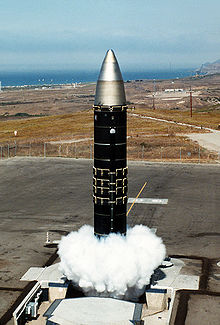Missile silo
A missile silo is understood to be an underground launching device for military missiles , in particular nuclear ICBMs . The purpose of a silo is to enable the missile to be fired quickly and to protect it from external influences, including an enemy attack with nuclear weapons . The pressure up to which a rocket is protected in the silo is given as a measure of the hardening of a silo against an external explosion .
During the Cold War , the development of missile silos began in the late 1950s in both the United States and Great Britain and the Soviet Union . The first rockets in the USA suitable for silos were so-called silo-lift variants for the Atlas F and Titan I ICBMs. In this variant, the rocket is stored vertically on a large hydraulic lifting system. After a start command, the rocket is refueled in the silo, the cover opens, the rocket is lifted to the surface and launched from there. These silos could withstand an overpressure of 690 kPa.
At the same time, the development of the Titan II missile silos began, which should enable the launch directly from the silo. The US intervened in this case to British developments under the set Blue Streak - medium-range missiles back program. The first successful launch of a rocket from a silo took place on May 3, 1961 from the Silo Launch Test Facility of Vandenberg AFB in the USA with a modified Titan I. This generation of rocket silos were designed for a hot start, i.e. the engines ignite Silo and the exhaust gas jet is deflected by a flame deflector into one or two exhaust shafts at the bottom of the silo. Titan II rockets were stationed in such silos from 1963. The Titan II silos were hardened to 2000 kPa overpressure. Both the first silo-lift versions and the silos for the Titan II had in common that the launch control center was directly connected to the silo (in the case of the Titan I even three silos) and the teams on watch had daily contact with "their" rockets . The first Soviet missiles in missile silos were the R-12 U and R-14 U medium-range missiles, followed by the R-16 U and R-9 intercontinental ballistic missiles from the mid-1960s.
From 1964, the USA stationed the compact Minuteman rocket. Like the Titan II, it was stationed in silos for hot in-silo take-offs. Due to the smaller size, these silos could withstand a pressure of 6 MPa. In contrast to the previous missile complexes, the Minuteman silos were no longer directly connected to a launch control center. At the Minuteman, a central launch center controls ten silos in the area at a distance of several kilometers from one another.
The third type of silo was introduced by the Soviet Union in the 1970s for the MR UR-100 and R-36M and is based on the launch system of missiles on submerged submarines . The rocket is mounted in a launch canister, which in turn is inserted into a silo. At the start, the rocket is shot out of the silo by means of a cold gas system and the rocket engines only ignite after leaving the silo (cold launch). This has the advantage that the silos can be constructed more simply, since no exhaust gases have to be discharged from the silo. Furthermore, existing silos of older missiles could easily be made usable for the new systems and the silo could be reloaded relatively quickly. The US introduced this system for the Peacekeeper missile in 1988. This launch system is also used for the mobile missile systems introduced in the Soviet Union in the 1970s, except that the launch canister with the missile is not hung in a silo, but rather mounted on a vehicle.
In addition to medium-range and ICBMs, the Soviet Union and the USA also stationed interceptor missiles and missiles for emergency communications in silos. The Ground Based Interceptors of the National Missile Defense in Alaska are stationed in silos. Russia is also conducting satellite launches from silos with the Dnepr launcher, which is based on the R-36M.
Web links
Individual evidence
- ^ A b David Stumpf Titan II - A History of a Cold War Missile Program. University of Arkansas Press, 2000, ISBN 1-55728-601-9 .
- ↑ R-12 / SS-4 SANDAL
- ↑ R-14 / SS-5 SKEAN
- ↑ Nuclear Rain: The RSVN [sic]

